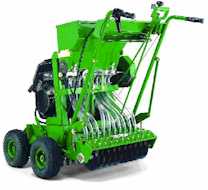|
|
|
 |
 |
 Lawn Overseeding What is overseeding? Overseeding is the planting of grass seed directly into existing turf, without tearing up the turf or the soil. It's an easy way to fill in bare spots, improve the density of turf, establish improved grass varieties and enhance your lawn's color. If a lawn looks old, or just "worn out," if it needs growing amounts of water and fertilizer to thrive, or is disease or insect prone, it's a perfect candidate for overseeding. BENEFITS OF OVERSEEDING. Many older lawns were established with common type turf grasses not suited for the needs of today's homeowner. They're often more disease and insect prone, requiring more fertilizer and water. Overseeding newer turfgrass varieties into an older lawn can help it better withstand insects, disease, drought, shady conditions and heavy traffic. The investment in overseeding pays off by reducing the amount of fertilizer, water and pesticides required. Most importantly, a renovated lawn stays greener and looks thicker and healthier. BEFORE YOU OVERSEED. For various reasons, old turf sometimes deteriorates dramatically or dies out completely. Overseeding with an improved grass seed mixture can get new turf growing in bare areas as well as "sprucing up" areas where the turf is thin and unhealthy looking. First, however, you must analyze the problems that caused the original turf to deteriorate. It might be due to conditions that, if not corrected, will eventually cause the overseeded lawn to deteriorate too. Correctable problems include: * Poor soil condition * Improper drainage * Soil compaction * Insufficient water * Poor fertility * Poor air circulation * Insufficient sunlight * Excess thatch * Grass varieties not suitable for area * General neglect If you have trouble identifying the problem, ask your local lawn professionals or your county extension office. The main thing is to correct the problem before you establish new grass. OVERSEEDING PREPARATION. Although not always mandatory, "core aerification" can be a beneficial first step in preparing worn-out turf for overseeding.  Proper aeration: * Relieves soil compaction * Speeds up thatch breakdown * Improves water intake and percolation through the root zone * Improves fertilizer intake * Enhances air exchange between soil and atmosphere * Ensures better seed-to-soil contact * Improves turfgrass root development for stronger plants OVERSEEDING METHODS. 1. Slit-seeding with a mechanical slit-seeder. This is the best method for overseeding established turf. Slit-seeders usually have verticutting blades that cut through the thatch layer and open up a slit or miniature furrow 1that follow in the slits and keep them Ž4-inch in the soil. The slit-seeding unit should have concave disk blades open while the seed is dropped; it ensures the seed gets into the soil where it can germinate. Slit seeding generally takes less seed than broadcast seeding because most of the seed gets into the soil so it can germinate. More seed-to-soil contact means a higher germination rate and a better stand of new grass. We recommend making two passes, seeding at 50 percent of the recommended rate. Make the two passes at a 45 angle to each other, leaving a diamond-shaped pattern. This method is fast, and results in the seed being placed a maximum of 2 inches apart. A "full" cover will be produced faster, even with grasses that do not spread. Some overseeders drop seed in 3-inch rows that will give a striped appearance to the lawn. Note: Before overseeding, check your lawn for thatch. If the thatch is more than 1Ž2-inch thick, dethatch before seeding. 2. Broadcast seed with a cyclone or drop-style seeder. This second method of overseeding is also effective, if you're unable to use a slit-seeder. Aerate several times before broadcasting seed; aeration holes should be spaced not more than 2-3 inches apart. Use core-type-aerating tines that remove soil plugs for better seed-to-soil contact. After overseeding, give the area a heavy watering right away to wash seed into the aeration holes and break up the aeration cores on the surface. One challenge with broadcast seeding is that much of the seed gets "hung up" in the thatch layer and does not get into the soil where it can germinate. Be sure to use grasses (such as bluegrass) that have a "creeping" growth method to ensure even growth; grass types that do not spread will grow in the aeration holes only and give the turf a "clump" or "spotted" look. AFTER OVERSEEDING. Depending on conditions and type of seed, new grass seed will begin to emerge 5 to 7 days after seeding when moisture and soil temperatures are adequate. An overseeded lawn can be fully established in eight weeks or less. Proper watering is critical to successful overseeding. The following is a recommended watering program. * Immediately after overseeding: Water heavily to wash grass seeds into slits. * Until grass seeds germinate (first 10 to 14 days): Water lightly on a daily basis, soaking first 1 inch of soil. * After germination: Water less frequently, but allow for deeper soaking and penetration into soil. This encourages deeper root growth. * After grass becomes established: Water at the recommended level for the type of grass planted. The key is care and patience. Proper overseeding will produce a healthier, better-looking lawn that responds better to mowing, fertilizing and watering. An added benefit is increased property value! TIMING OVERSEEDING. Late summer or early fall is the best time to overseed lawns. Soil and atmospheric temperatures are most favorable for optimum seed germination and growth. With adequate moisture, fertilizer and sunlight, the new seedlings will be well established before cooler fall weather sets in. Also, weed competition is less of a factor at this time, giving the grass seedlings a better environment to grow and develop. Spring overseeding risks the chance of weather-related problems (heavy spring rains, unexpected high temperatures) and weed competition. Also, spring seeding may interfere with the application of pre-emergent crabgrass or broadleaf weed killers; concurrent application of seed and herbicides is generally not recommended because the herbicides may cause poor seedling establishment. It is best to delay herbicide treatment 4 to 6 weeks after new grass seed germinates. If you choose to overseed in the spring, be sure to follow proper seeding and treatment practices. Midsummer overseeding faces greater chances of disease, heat and drought stress, and weed competition. Proper weed control and adequate irrigation are musts if overseeding is attempted in midsummer. Dormant overseeding involves seeding in late fall or early winter, after soil temperatures are low enough to prevent seed germination. Success usually requires good snow cover during the winter, to prevent wind or water erosion and ensure germination doesn't begin too early. This method is sometimes preferred over spring seeding, especially in northern areas, because you don't have to wait for soil or moisture conditions to improve before overseeding. TURF SEED TO OVERSEED. Your choice of grass is generally determined by your area's climate. Cool-season grasses, such as Kentucky bluegrass, perennial ryegrass, bentgrass and the fine fescues, are used primarily in western, northern and eastern areas of the United States. They tolerate moderate summertime temperatures but will also survive severe cold associated with northern winter conditions. Warm-season grasses, such as bermudagrass, centipedegrass and bahiagrass, are used in the south, southeast, and southwest United States. They'll withstand extreme heat, but are unable to tolerate sustained temperatures well below freezing. Tall fescues are used extensively in the midsouth and west regions and with the advent of new turf-type tall fescues, their use is expanding into other geographic areas as well. For detailed recommendations, contact your lawn care professional or county extension agent. SHOULD YOU START OVER? Proper overseeding can renovate a lawn if it has at least 50 percent or more healthy turf. However, if your lawn has less than 50 percent healthy turf, it may be better to kill out the old turf, weeds, etc., and reseed the entire lawn. RENOVATION STEPS. 1. Apply a broad-spectrum herbicide to kill all vegetation. a. Apply at the recommended rate, when grass and weeds are actively growing. b. Don't spray when rainfall is expected within 24 hours. c. Don't spray when windy, to avoid drift into shrubs, trees, neighboring lawns, etc. d. Don't walk from treated onto untreated areas. e. Allow the herbicide to work for 7 to 10 days before starting follow-up renovation steps. 2. Use a power rake to dethatch and remove excess (1Ž2 inch or more) thatch debris from the treated lawn. 3. Aerate thoroughly, using a core-type aerator. 4. Fertilize with a good starter fertilizer. Apply at the recommended rate. 5. Re-seed, using a mechanical "slit seeder." Note: Whether or not a broad-spectrum herbicide is used, it usually works better to overseed new grass into the old, undisturbed turf, even if it is dead, rather than start with bare dirt. Overseeding is faster and easier than completely digging up the soil, and it leaves some cover to against wind or water protect erosion of the soil surface. |
|
|